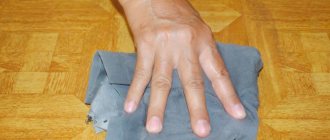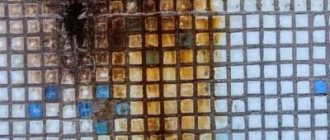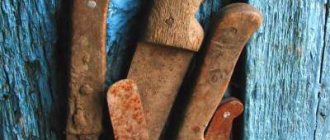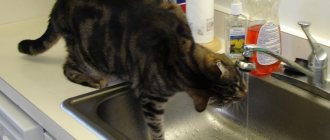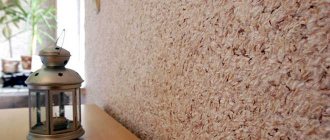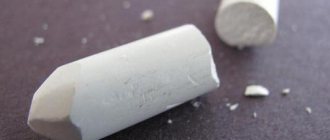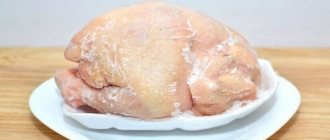Linoleum is a very popular floor covering due to its technical and operational properties, reasonable price, and wide variety of color shades. It easily tolerates different types of cleaning - both dry and wet.
But sometimes hard-to-remove red or brown stains from standing metal objects that have become embedded in the material appear on it. How to remove rust from linoleum? What folk methods and special means are suitable for this, and what is not recommended to use in order to avoid damage to the contaminated surface?
Traditional methods
The materials used to get rid of stains using traditional methods are mostly publicly available, inexpensive, and can be found in almost any home:
- Lemon acid. Sprinkle on the rust stain and then wash off with water. To enhance the effect, dissolve 1 teaspoon of citric acid and salt in 1 glass of hot water, and treat linoleum with the resulting solution. If necessary, the procedure can be repeated.
- Lemon. A rag is generously moistened with lemon juice, applied to the stain and left for a while. Then the stain is wiped off with the same rag. Second option: instead of a rag, apply a piece of lemon to the rust.
- Acetic acid. Dissolve 1 tbsp in 1 glass of warm water. spoon of acetic acid. Immediately after treating the stain with the specified product, the stain is wiped with hydrogen nitride (ammonia).
- Kerosene. Generously moisten the rusted surface with the flammable mixture and leave for 30-40 minutes. After time, thoroughly wash off the kerosene with cold water.
- Baking soda. A natural product known for its cleansing properties, thoroughly rub the rust-affected area, then rinse with water.
- Potassium salt of tartaric acid (tartar). Mix 1 tbsp. l. crystals and 2 tbsp. l. water. The prepared paste is applied to the stains, wiped thoroughly with a brush, and washed with water.
- Soda. Carbonated drinks containing orthophosphoric acid (Fanta, Coca-Cola, etc.) cope well with the problem. You can moisten a rag with one of them and wipe the rusty areas. Another way: pour the soda into a spray bottle and apply it to the linoleum.
To obtain a more effective result, the methods can be combined with each other.
Tip: after removing rust stains from the linoleum with a woolen rag, apply linseed oil or drying oil in their place. Leave for a day, then rub the surface until shiny. This will return the coating to a well-groomed appearance.
Traditional recipes for use at home
Folk remedies will help you easily wash linoleum from rust stains.
Lemon acid
Cleaning with citric acid pulp will help quickly remove red stains from the floor covering.
Algorithm of actions:
Salt will help enhance the effect of citric acid. It is added and thoroughly ground in the already prepared cleaning composition.
Fresh lemon
A small piece of fresh lemon will not only help get rid of rust stains, but will also fill the room with a pleasant, refreshing aroma.
Algorithm of actions:
How to remove with vinegar and ammonia?
A solution of ammonia and acetic acid can remove stubborn rust stains from linoleum.
Algorithm of actions:
Work with ammonia and acetic acid is carried out only in a respirator, in a room with good ventilation. Otherwise, there is a high risk of respiratory tract burns and solvent vapor poisoning.
Kerosene
Kerosene will help remove old rust stains.
Algorithm of actions:
Baking soda
A universal folk remedy - baking soda will help you quickly get rid of traces of rust on linoleum.
Algorithm of actions:
When mixing soda with water, you must ensure that the abrasive particles dissolve completely. Otherwise, scratches may appear on the linoleum.
Potassium salt
Remove old rust stains using potassium salt (tartar).
Algorithm of actions:
Work with potassium salt is carried out only with protective rubber gloves.
How to remove with carbonated water?
The secret to soda's effectiveness in fighting rust stains is simple. Sweet water (Coca-Cola is great) contains citric acid, which dissolves rust particles on linoleum.
Algorithm of actions:
Special means
In hardware stores you can purchase various special products for cleaning linoleum from rust stains:
- liquid cleaning products of the Sanox series, which contain oxalic acid, which copes well with rust;
- Cif brand cleaning cream;
- bleach (popularly known as bleach), chlorine-containing bleaching agents (for example, “Belizna”), diluted in water in a ratio of 1:10 and applied to the rust for about 1 hour.
Before using household chemicals, it is advisable to first check the possible results of their impact on linoleum by applying a small amount of the product to an inconspicuous area of the coating. After treatment with these products, the linoleum should be thoroughly washed with warm water and wiped with lemon juice.
Important! Be sure to use gloves when cleaning linoleum from rusty stains with special products. After finishing the procedure, ventilate the room well.
Baking soda and vinegar - two cleaning methods
Using these substances, you can quickly get rid of rusty stains in the toilet bowl. There are two ways to proceed.
- Bring 1 cup of table vinegar to a boil. While it is still hot, add baking soda. Apply the hot mixture to areas with rust. After 2-3 hours, rinse the surface of the toilet with running water.
- Pour a small amount of water into the baking soda and mix thoroughly to form a homogeneous paste. Apply the mixture to the contaminated surface and leave for an hour. Pour vinegar into a spray bottle and wet the walls of the plumbing with it. When the chemical reaction is complete and the mixture stops fizzing, flush the water out of the tank.
In both cases, you can finally treat the surface of the toilet bowl with a soap solution. Any liquid soap is suitable for its preparation.
What is not recommended for processing linoleum
There are products that should not be used in the fight against rust stains on linoleum.
These include:
- water too hot;
- drugs that have a strong alkaline reaction;
- abrasive materials (emery, pumice, etc.);
- aggressive disinfectants.
These products can adversely affect the condition of the coating, damage it, and ruin its appearance.
Do not be upset if rust stains are found on the linoleum. Proper use of folk methods and special means can completely eliminate this problem.
How not to treat linoleum
Not recommended for cleaning:
- Abrasive materials.
- Products with a strong alkaline reaction.
- Aggressive disinfectants.
- Very hot water.
Important! These products can damage the surface of the linoleum, make it dull or change color.
To prevent dirt from accumulating on the linoleum, forming stains that are difficult to remove, it is recommended to do wet cleaning daily. Warm water, at a temperature of approximately 35 degrees, is suitable for this. You can add laundry soap or a special product to the water for washing the floor. Please note that the packaging of this flooring product indicates whether it is suitable for linoleum flooring.
To protect the top layer of linoleum, it is better to use polish. As a result of these actions, a protective layer is formed on the surface. To give a beautiful shine, it is recommended to rub the linoleum coating with linseed oil or drying oil once a month. This will also protect against cracks.
Almost every housewife has questions about how to remove rust from linoleum, since this is the most popular type of flooring. Sometimes various kinds of difficult-to-remove contaminants appear on it. To avoid damaging the paint or structure of the material when cleaning, use some already proven methods and household solvents suitable for removing contaminants.
Adviсe
A few tips from experienced housewives and cleaning company specialists will help speed up the process of removing difficult rust stains and restoring the original appearance of the floor covering:
- After the rust stain has been removed, wipe the linoleum with a cloth moistened with linseed oil or drying oil. Such actions will help restore the flooring to its original well-groomed appearance.
- Simultaneously using several rust removal methods (for example, baking soda and carbonated water) will help speed up the cleaning process and achieve the best result.
- After using chemicals, linoleum must be thoroughly rinsed with warm water and then wiped with a slice of lemon. This will help restore the shine to the flooring.
Careful handling extends the life of linoleum. During the cleaning process, do not use sharp metal objects or hard brushes. You should also avoid prolonged contact of the floor covering with aggressive chemical compounds.
Removing stains from linoleum
This coating easily withstands dry and wet cleaning. But before you start removing the stain, you should determine the type of contamination. The most common of them are:
- from fat;
- from spilled greenery or iodine;
- the appearance of mold;
- rust marks;
- ink stains from a marker or felt-tip pen;
- drops of paint.
Once the type of contamination has been determined, it is necessary to choose the correct method for eliminating it.
Green stains
The bottle of brilliant green solution cannot always be opened carefully, so it may accidentally spill on the floor. It is easiest to remove fresh markings before they become too deeply ingrained into the surface. It is wiped with a solution of powder and warm water until it disappears. If the pattern on the linoleum is light in color, then use bleaches: chlorine gels, hydrogen peroxide or laundry soap.
When you try to wash a stain from linoleum with a cloth, do not spread it too much beyond the blot so that the area of contamination does not increase. Then moisten cotton wool with hydrogen peroxide and wipe off the remaining brilliant green. As the tampons become dirty, they need to be changed until there is no trace left of the stains.
If hydrogen peroxide is not available, you can sprinkle soda on the brilliant green and pour a thin stream of vinegar over it. At the same time, the foam will absorb the color. The procedure can be repeated several times, since this method is safe for linoleum.
White spirit or other alcohol can help remove an old green stain from a medical antiseptic. Do the following procedure:
- Protect your hands with rubber gloves from the harmful effects of the cleaning product.
- Soak a kitchen sponge in one of the above solutions and remove the brilliant green with it. If it is strongly ingrained into the surface of the linoleum, then the solution should be poured for 10-15 minutes, and then wipe the area again.
- After working with solvents, rinse the area with clean water to completely remove any remaining household chemicals.
Process Details
Unusual cleaning options
If it was not possible to deal with the contamination using the methods described above, then you can try the following options:
- You will need a piece of laundry soap, which you need to grate and mix with PVA glue in the amount of two tablespoons. The resulting slurry should be filled with 3-4 liters of warm water. Boil the kettle in the resulting solution for 30 minutes and then rinse it. This is a good way to get rid of rust and oil stains.
- Mustard powder should also be applied to the surface of the kettle and left for 20 minutes, then rinsed.
How to clean grease from a metal kettle
The difficulty in cleaning aluminum cookware lies in its sensitivity to abrasives and poorly selected products. For an aluminum kettle, you can use a mixture of vinegar and lemon juice. These substances are mixed in equal parts and added to water. For a regular-sized teapot, two tablespoons of both products are enough. The dishes are rubbed with the resulting mixture and left for 30 minutes, and then all dirt can be easily removed. An additional option is to apply any detergent to the surface, which can be left for 30-60 minutes. Then remove all dirt from the kettle and rinse the kettle with water.
How to clean grease from an enamel kettle
Toothpaste is another excellent folk remedy. It is used to remove small greasy stains. An old toothbrush is suitable for this; apply the paste to the surface of the kettle, rubbing lightly. Then you just need to wash off the dirt with water and wipe it dry.
REFERENCE! A paste without a bleaching effect is most suitable for this, because it does not contain fine abrasives and it is not capable of damaging the surface of the kettle.
To clean the kettle, you can use a solution of table salt (2 tablespoons per liter of water), in which you need to boil it. After this treatment, oil stains will be removed much easier. This method can only be used for enamel teapots, since steel models may be damaged after such treatment.
Citric acid can also help remove fat. Powder in the amount of 1-2 tbsp. dissolve in a liter of water and place the dirty kettle there. The container with the kettle is boiled for 20-30 minutes and then left to cool. Then the kettle needs to be removed and washed with water.
Cleaning the glass surface of a teapot from grease
A glass teapot must be washed very carefully. Abrasives cannot be used in this case, because they will leave scratches on the surface. Household chemicals are suitable for this, for example, Cillit, Frosch, Schumanit. The main thing is that the product is in liquid or gel form. These products can only be applied to contaminated areas and only with gloves, so that the active substance affects the dirt and does not damage the surface. The product is left on the surface for 15-20 minutes and washed off first with warm and then with cold water. If this is necessary, then the kettle is boiled again so that it is cleaned not only outside, but also inside.
REFERENCE! Household chemicals are very toxic and when using them it is better to use gloves, as this can cause skin irritation.
In the future, it is best to place glassware away from cooking fatty foods. This is because high temperatures cause cracks in the surface due to hot oil splashing.
How to clean an electric kettle
Electric kettles can only be washed after they have been unplugged. It is connected back to the cable only after the kettle is completely dry after washing. In order to remove dirt from plastic, products with an aggressive composition (soda or citric acid) are not suitable. If you find any carbonated drink in the house, then you don’t have to look for a cleaning product. It is better to choose soda without dyes, otherwise the light teapot may become stained.
Grease stains are treated with sparkling water and left for 30-60 minutes. After this, the dirt is wiped off with a sponge and washed off with water. Scale is also removed from the kettle using soda, which needs to be poured into the kettle and boiled. The cleansing effect is achieved with the help of acids that make up carbonated water.
Lemon is also used to clean an electric kettle; it only needs to wipe the surface. It helps remove fat and lighten yellow spots.
How to restore shine to linoleum
There are several ways to help restore the original shiny surface of linoleum:
- Dissolve milk in water (1:1) and rinse the floor with this solution several times.
- Wipe with a soft cloth and soapy water and dry the coating thoroughly. Then treat it with a woolen cloth with the addition of drying oil or vegetable oil. (First test the method on an inconspicuous area, since oil solutions can erase paint from some linoleums).
- Treat the floor with mastic.
The service life of linoleum will be extended if you use these tips:
- Avoid using hot water, hard tools and abrasives.
- Chemicals with strong alkalis and acids can damage paint.
- Use special products designed for caring for PVC products.
- Remove stains immediately after they occur.
- All dirt can be removed using window cleaners that contain alcohol.
The service life of linoleum will increase if you treat it with care and regularly care for such a coating. Hard brushes and harsh chemicals contribute to wear. If stains suddenly appear on the linoleum, try to remove them immediately so that they do not spoil its appearance and the structure of the material. Remember these tips, and the floor will delight both you and the guests of your home with cleanliness.
The magic of rust dissolution rests, as experts say, on three main pillars:
1. Corrosion of rust. The composition of the product is selected in such a way that it seems to moisten this very rust, as if in front of it is the same Borodino bread, thus decomposing it into its component parts.
2. This process is preceded by the very displacement of moisture from the compound, the main catalyst for the destruction of the metal.
3. After this, on the surface of the metal under the destroyed rust, thanks to a chemical process, a lubricating film is formed, which will allow the stuck joint to move out of its place more easily in the future, and secondly, this film will not allow new corrosion to form on the metal surface in the future. In any case, until the chemical liquid completely flows out of there.
As for the protective film remaining on the metal surface, there are two types, it all depends on the composition of the product. Either this chemical layer is resistant to corrosion, or it is an oil film that repels water.
Thus, we must remember that the second active “ingredient” for use is the ability of this composition to enter into an active chemical reaction and dissolve metal decomposition products.
Also, do not forget that the very purpose of various “liquid keys” may be different. This is clearly seen from the video on the YouTube channel of the magazine “Behind the Wheel”, as well as in the useful applied automotive program “Technical Environment”:
As can be seen in the frame from the “Technical Environment” program, all four means for unscrewing bolts are of different colors. The very purpose of their use lies in their coloring.
The liquid on the far right in the video has a light golden hue. Pavel Leonov, editor of the Za Rulem magazine, explains that this is primarily due to the fact that the composition of this liquid mostly contains solvents. This tool was developed specifically for unscrewing threaded connections.
The slightly darker composition of the liquid already contains more oil, which implies its more universal use.
The third composition is more similar in color to kvass; it contains the highest percentage of oil. It is inherently lubricant, with a water-repellent effect.
The fourth lubricant, as many have already guessed, is WD-40. Let's look at the experiment, how different products differ from each other, how much better or worse they cope with rust:
Video taken from the YouTube channel “Behind the Wheel”
A visual video, isn’t it, dear readers?
Here is another experimental video that clearly demonstrates the penetrating abilities of various compositions:
Video taken from YouTube channel “Project Farm”
It is clearly visible here that the penetration properties of liquids with different chemistry are different for everyone.
Conclusion:
Thus, from everything shown and described, the following conclusion can be drawn. -Not every tool that is designed to unscrew soured bolts does its job equally efficiently and reliably. Before purchasing this penetrating oil of a particular brand, you should read the reviews about the use of this chemical in advance. Remember that liquids with a high percentage of solvent have a detrimental effect on rubber parts, boots, rings and other easily soluble parts. Conversely, if the bolt is already heavily rusted, then there is no point in using a fluid with a high oil content.
You should also not rely on penetrating lubricants as an absolute solution to the problem. Sometimes it happens that heavy artillery has to be used against well-soured, stuck-on bolts. We have published links with illustrative examples above.
PS “Liquid key” can be made at home, i.e. For example, use such available means as kerosene (has excellent penetrating properties), or a solution of citric acid, as well as lemon juice or Coca-Cola. For example, you can use and apply it like this:
